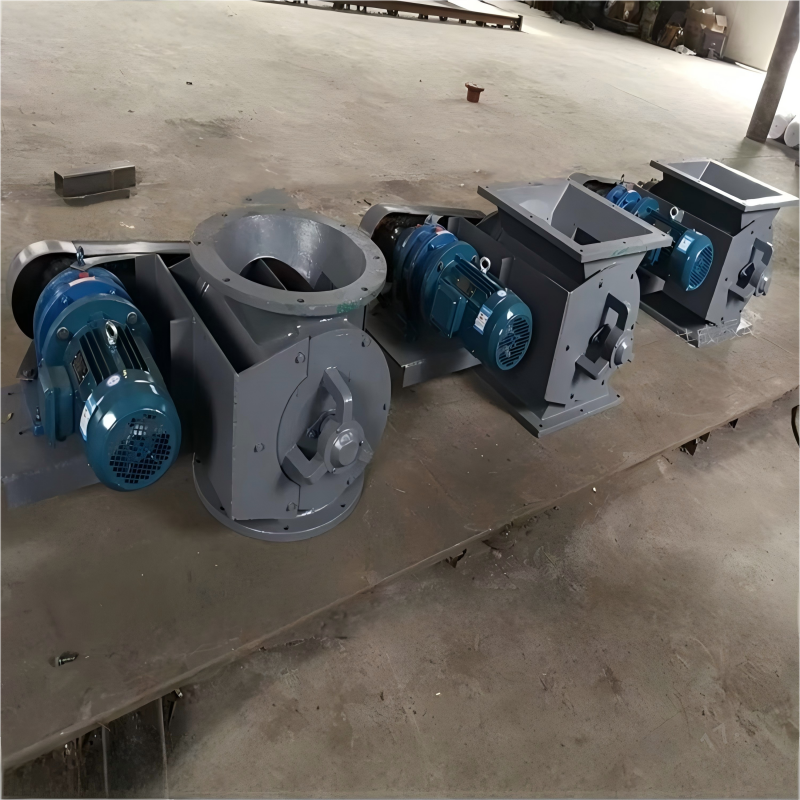Star Discharge Valve
The Star Discharge Valve is a specialized discharge equipment for pneumatic conveying systems. It primarily serves dual functions: continuous material discharge and air pressure isolation. Its core structure comprises a rotor impeller, housing, reducer, sealing assembly, and motor. Material is discharged in measured quantities through impeller rotation while preventing air ingress into the negative pressure system that could cause pressure imbalance.
This equipment is categorized into standard, pressure-resistant, and high-temperature types. The high-temperature variant can handle materials up to 500°C, featuring a sprocket-driven connection and bearing isolation design. It finds extensive application in environmental protection, metallurgy, chemical processing, grain handling, and other industries, serving as an ash discharge solution for dust collection systems or as a silo unloader for powdery and small-particle materials. Featuring a compact structure, smooth operation, and superior sealing performance, its bearing-separated housing design accommodates high-temperature environments. Custom configurations are available to meet diverse operational requirements.
The Star Discharge Valve is installed at the discharge port of unloaders operating under negative pressure. It receives material discharged from the unloader at the top, conveying it via a rotating impeller while simultaneously providing sealing to prevent air ingestion through the discharge port during pneumatic conveying. This ensures normal material discharge from the unloader. As a specialized unloading device, it plays a significant role in cleaning and maintenance operations.
Working Principle
I. Star discharge valves are commonly used in pneumatic conveying systems. For both pressure and vacuum conveying systems, they ensure uniform and continuous material feeding into the conveying pipe. This maintains a stable gas-to-solid ratio within the pneumatic conveying line, enabling normal operation while simultaneously isolating the pressure between the upper and lower sections of the valve to achieve airlock functionality. Thus, the star discharge valve is a critical component in pneumatic conveying systems.
II. Material from the upper hopper falls by gravity into the gaps between the blades. As the blades rotate, the material is discharged at the bottom. This enables the star discharge valve to discharge material quantitatively and continuously.
III. The star discharge valve can be used in material collection systems as a hopper discharge device. It is currently the most advanced discharge apparatus in China, commonly employed as a key component in dust collection systems. It is particularly suitable for dust and small-particle materials, making it a preferred choice for projects in environmental protection, metallurgy, chemical engineering, grain processing, cement production, road construction, and drying equipment industries.
IV. High-Temperature Type It can handle materials up to 280°C. Bearings at both ends are isolated from the impeller, preventing contact between ultra-fine powder and bearings. The high-temperature discharge unit accommodates materials up to 500°C, utilizing sprocket connections. The reducer and discharge unit housing maintain a specific distance.
Classification
Star discharge valves are categorized into three main types: standard, pressure-resistant, and high-temperature resistant.
Pressure-Resistant Type: Featuring a sealed rotor, it is widely applicable in suction-type, pressure-type pneumatic conveying systems, and negative pressure conveying equipment. It ensures no leakage of air pressure within the conveying pipeline, enabling safe material transport and discharge. Thus, it is also known as an airlock valve. It not only withstands pressure but also possesses the functions of the standard type.
High-Temperature Type: Designed for materials with significant temperature rise at discharge points. Temperature affects body expansion and adversely impacts bearings and sealing systems.
Standard Type: Suitable for materials below 80°C and ambient temperatures. It provides continuous, uniform feeding into conveying pipes while functioning as a discharge device in system separation and dust collection sections.
Precautions for Use
1. Before operating the star-type unloader, check the quantity and type of lubricating oil in the reducer. Replace the oil after one month of operation, then annually thereafter.
2. Connect the air source interface while inspecting it for blockages by foreign objects. Ensure the interface is clean and unobstructed.
3. Before operation, confirm the rotor rotates clockwise (as viewed from the gearbox output shaft, matching the arrow on the sprocket cover).
4. Before operation, open the sprocket cover to check chain tension. Perform regular inspections during operation. Apply appropriate grease to the chain and sprockets.
5. Throughout operation, adjust the pressure reducing valve to maintain a seal pressure 0.05 MPa higher than the material pressure inside the valve body. Use oil-free, dry compressed air for this purpose.
6. Maintain a continuous air supply to the seals during all operation. Only shut off the air supply after confirming the valve is completely stopped.
Application Areas
Widely used in environmental protection, metallurgy, chemical engineering, grain processing, cement, and other industrial sectors, it commonly serves as a discharge device for dust collection equipment within dust removal systems. It can also function as a feeding and discharging mechanism for various mills, dryers, silos, and other equipment.

Star Discharge Valve-Figure 1

Star Discharge Valve-Figure 2
WHY CHOOSE US
1. Reliable Quality Assurance System
2. Cutting-Edge Computer-Controlled CNC Machines
3. Bespoke Solutions from Highly Experienced Specialists
4. Customization and OEM Available for Specific Application
5. Extensive Inventory of Spare Parts and Accessories
6. Well-Developed Worldwide Marketing Network
7. Efficient After-Sale Service System
We are not just a manufacturer and supplier, but also an industry consultant. We work pro-actively with you to offer expert advice and product recommendations in order to end up with a most cost effective product available for your specific application. The clients we serve worldwide range from end users to distributors and OEMs. Our OEM replacements can be substituted wherever necessary and suitable for both repair and new assemblies.




















